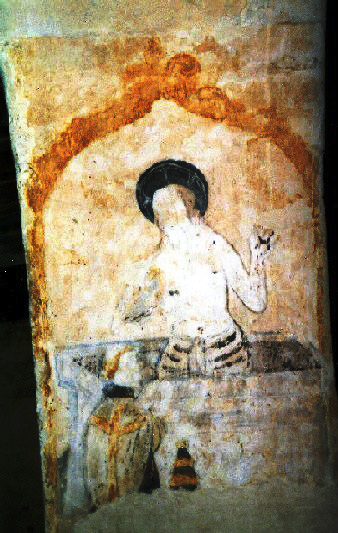Slapton, Northamptonshire (†Peterborough) C.14/15
Mass of St Gregory, with The Image of Pity

A very great rarity; the subject known primarily as the Mass of St Gregory and uncommon in England. St Gregory is Gregory the Great (540-604?), one of the (western) Fathers of the Church and the Pope responsible for sending St Augustine to England. The legend behind this painting tells the story of how Gregory, dismayed to find an unbeliever among his flock, prayed for a sign to confirm the reality of the Atonement and its re-enactment in the Mass. In response, an image of Christ with the Instruments of the Passion appeared above the altar.¹
No Instruments of the Passion are visible here now, but they might once have been painted around the figure of Christ, who stands upright in a sarcophagus displaying his wounds – blood, now blackened with age, is just visible issuing from his raised left hand.
Gregory, in archiepiscopal robes, kneels below, in front of the sarcophagus at the left, and the whole scene is framed in a painted yellow arch.
I do not know of another wall painting of the Mass of St Gregory in England, but a few examples still exist on screen panels and the like. According to Eamon Duffy there is one at Wellingham in Norfolk and another at Wyverstone, Suffolk. Although the Mass of St Gregory has an obvious claim to be a record of an historical incident, it is also clearly a ‘devotional’ image, and many examples in wall painting may have been destroyed (the Wyverstone panel is very severely mutilated – iconoclasts hated this image). Some others though survive in primers and other books, as documented and discussed by Duffy. A panel at Ashbourne, Derbyshire which includes an Image of Pity is at present known to me only from a photograph.
Additionally, there is a relationship here to the Warning to Swearers, as at Michaelchurch Eskley and elsewhere. And the relationship between this subject and other ‘Warning’ moralities, in this case the Warning to Sabbath Breakers, is made very explicit in this example from Rhäzüns (Eglise St-Georges) in Switzerland.
Most of Slapton’s many paintings are now on the site. They are the Weighing of Souls, St Christopher, the Suicide of Judas, St Francis Receiving the Stigmata, the Annunciation, St Eloi shoeing the Possessed Horse and the Warning against Idle Gossip.
¹ Eamon Duffy, The Stripping of the Altars, Yale, 1992, pls. 50, 139. Duffy also discusses the whole relationship of the ‘devotional’ Image of Pity, which is often found separately, with no reference to St Gregory, and the ‘historical’ Mass of St Gregory proper.